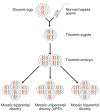Chromosomal mosaicism: Origins and clinical implications in preimplantation and prenatal diagnosis
- PMID: 33720449
- PMCID: PMC8176867
- DOI: 10.1002/pd.5931
Chromosomal mosaicism: Origins and clinical implications in preimplantation and prenatal diagnosis
Abstract
The diagnosis of chromosomal mosaicism in the preimplantation and prenatal stage is fraught with uncertainty and multiple factors need to be considered in order to gauge the likely impact. The clinical effects of chromosomal mosaicism are directly linked to the type of the imbalance (size, gene content, and copy number), the timing of the initial event leading to mosaicism during embryogenesis/fetal development, the distribution of the abnormal cells throughout the various tissues within the body as well as the ratio of normal/abnormal cells within each of those tissues. Additional factors such as assay noise and culture artifacts also have an impact on the significance and management of mosaic cases. Genetic counseling is an important part of educating patients about the likelihood of having a liveborn with a chromosome abnormality and these risks differ according to the time of ascertainment and the tissue where the mosaic cells were initially discovered. Each situation needs to be assessed on a case-by-case basis and counseled accordingly. This review will discuss the clinical impact of finding mosaicism through: embryo biopsy, chorionic villus sampling, amniocentesis, and noninvasive prenatal testing using cell-free DNA.
© 2021 John Wiley & Sons Ltd.
Conflict of interest statement
Figures





Similar articles
-
Chromosomal Mosaicism in the Placenta.Clin Obstet Gynecol. 2025 Mar 1;68(1):130-138. doi: 10.1097/GRF.0000000000000906. Epub 2024 Dec 23. Clin Obstet Gynecol. 2025. PMID: 39711465 Review.
-
Placental mosaicism in the era of chromosomal microarrays.Eur J Med Genet. 2020 Apr;63(4):103778. doi: 10.1016/j.ejmg.2019.103778. Epub 2019 Sep 30. Eur J Med Genet. 2020. PMID: 31580923
-
Chromosomal mosaicism in chorionic villus sampling.Clin Perinatol. 1990 Dec;17(4):867-88. Clin Perinatol. 1990. PMID: 2286032 Review.
-
Detection of mosaicism at blastocyst stage with the use of high-resolution next-generation sequencing.Fertil Steril. 2017 May;107(5):1085-1091. doi: 10.1016/j.fertnstert.2017.03.024. Epub 2017 Apr 6. Fertil Steril. 2017. PMID: 28390692 Review.
-
Accuracy of cytogenetic findings on chorionic villus sampling (CVS)--diagnostic consequences of CVS mosaicism and non-mosaic discrepancy in centres contributing to EUCROMIC 1986-1992.Prenat Diagn. 1997 Sep;17(9):801-20. doi: 10.1002/(sici)1097-0223(199709)17:9<801::aid-pd153>3.0.co;2-e. Prenat Diagn. 1997. PMID: 9316125
Cited by
-
Current Applications and Controversies in Preimplantation Genetic Testing for Aneuploidies (PGT-A) in In Vitro Fertilization.Reprod Sci. 2024 Jan;31(1):66-80. doi: 10.1007/s43032-023-01301-0. Epub 2023 Jul 29. Reprod Sci. 2024. PMID: 37515717 Review.
-
Preimplantation genetic testing for aneuploidy: The management of mosaic embryos.Clin Exp Reprod Med. 2022 Sep;49(3):159-167. doi: 10.5653/cerm.2022.05393. Epub 2022 Aug 31. Clin Exp Reprod Med. 2022. PMID: 36097731 Free PMC article.
-
Clinical Insights Regarding the Targeted Chromosomal Region for Mosaicism and Aneuploidy in Embryos in IVF Treatment and Literature Review.Diagnostics (Basel). 2025 May 29;15(11):1375. doi: 10.3390/diagnostics15111375. Diagnostics (Basel). 2025. PMID: 40506948 Free PMC article.
-
Case Report: Two cases of apparent discordance between non-invasive prenatal testing (NIPT) and amniocentesis resulting in feto-placental mosaicism of trisomy 21. Issues in diagnosis, investigation and counselling.Front Genet. 2022 Oct 25;13:982508. doi: 10.3389/fgene.2022.982508. eCollection 2022. Front Genet. 2022. PMID: 36386832 Free PMC article.
-
The Impact of Chromosomal Mosaicisms on Prenatal Diagnosis and Genetic Counseling-A Narrative Review.J Pers Med. 2024 Jul 21;14(7):774. doi: 10.3390/jpm14070774. J Pers Med. 2024. PMID: 39064028 Free PMC article. Review.
References
-
- Benn P, Grati FR. Aneuploidy in first trimester chorionic villi and spontaneous abortions: Windows into the origin and fate of aneuploidy through embryonic and fetal development. Prenat Diagn. 2020. - PubMed
-
- Chatzimeletiou K, Morrison EE, Prapas N, Prapas Y, Handyside AH. Spindle abnormalities in normally developing and arrested human preimplantation embryos in vitro identified by confocal laser scanning microscopy. Human reproduction. 2005;20(3):672–682. - PubMed
-
- Hardy K, Winston RM, Handyside AH. Binucleate blastomeres in preimplantation human embryos in vitro: failure of cytokinesis during early cleavage. J Reprod Fertil. 1993;98(2):549–558. - PubMed
-
- Levy B, Sigurjonsson S, Pettersen B, et al. Genomic imbalance in products of conception: single-nucleotide polymorphism chromosomal microarray analysis. Obstet Gynecol. 2014;124(2 Pt 1):202–209. - PubMed
MeSH terms
Supplementary concepts
Grants and funding
LinkOut - more resources
Full Text Sources
Other Literature Sources

